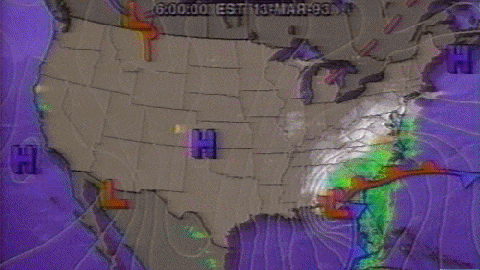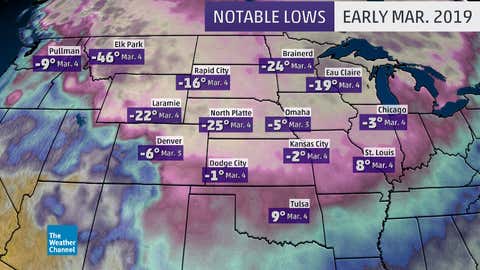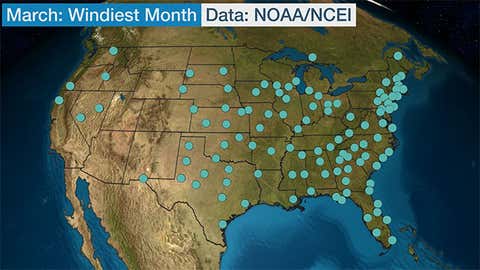March Weather Has a Stormy Reputation
Feb 24, 2021 01:02PM ● By Editor
By Jonathan Erdman of The Weather Channel - February 24, 2021
March can trigger spring fever, but its weather is often a moody mix of winter storms, lingering cold, flooding rain, wind, severe thunderstorms and tornadoes. We understand the itchiness this time of year, particularly in the northern U.S.
Spring training is underway. Minutes of daylight are added each day. The coldest time of year is usually in the rearview mirror.
But the tension between lingering winter cold and increasing spring warmth usually makes March a stormy month that often frustrates thoughts of sunny, warmer weather in areas with winter fatigue.
Here are the ways March weather can be anything but calm and quiet.
Snowstorms
March snowstorms can be the stuff of legends.
Along the East Coast, nor'easters can produce feet of snow, high winds and coastal flooding. In 2018, four such nor'easters buffeted the coast in the first three weeks of March.
The signature March storm in recent history was the Superstorm of 1993, which wrung out snow from the Florida Panhandle to Maine and drove a squall line with hurricane-like storm surge flooding into Florida.

Strong March winter storms also plague parts of the Midwest, Plains, Rockies, Cascades and Sierra Nevada. In March 2018, roughly 16 feet of snow fell in the Sierra of California in just 18 days.
March is the snowiest month, on average, in parts of the High Plains and Rockies, including Denver and Billings, Montana.

Spring Flooding
With warmer March temperatures comes the concern for spring flooding. This is often a problem in parts of the Ohio Valley, Mississippi Valley, Red River Valley – North Dakota and Minnesota – and parts of New England.
Several factors determine how severe spring flooding will be: how deep the snowpack is, whether a sharp warmup melts the snow too quickly, how saturated the ground was going into winter and how much rain or snow falls in spring.
In March 2019, a perfect storm of factors, including a so-called bomb cyclone, came together to trigger massive flooding in the nation's midsection, particularly in Nebraska and Iowa, that lingered for months.
While severe weather can occur any time of year the ingredients align, March is when arctic fronts typically become less potent. This allows warm, humid air to surge northward more often ahead of vigorous jet stream disturbances swinging out of the West.
Tornado counts in the U.S. typically double from February (41) to March (83), according to data from 2000 to 2019.
The tornado threat tends to be highest in March from the Southern Plains into the Tennessee Valley and Deep South. Central Florida can also be a tornado hot spot in March.

March U.S. tornado counts have varied tremendously over the past few years, from as few as 11 in 2015 to as many as 192 in 2017.
The past two Marches have started out with strong, deadly tornadoes in the South.
A nocturnal tornado outbreak March 2-3, 2020, killed 25 people in Tennessee. A single EF4-rated tornado was responsible for 19 of those deaths in Putnam County.
On March 3, 2019, an EF4-rated tornado killed 23 people in Lee County, Alabama.
A Feb. 28 to March 1, 2017, outbreak spawned 72 tornadoes in 11 states in the Midwest and South and led to 950 reports of damaging thunderstorm winds, high winds and large hail.
March Freezes Common
With the exception of typically warm areas such as the Florida Peninsula, South Texas and the lower Colorado River Valley, at least one March freeze is typical for much of the Lower 48 states.
A majority of the U.S. has to wait until at least April for the last spring freeze.
The farther north you live, and the higher the elevation, the more likely you usually must wait until at least May before morning temperatures stay above freezing for the season.

It Can Get Still Be Bitter Cold
March last year was much warmer than average for much of the nation, but one only has to look back to 2019 for a sharp reminder that the month can still have bitterly cold temperatures.
All-time March record lows were set in a number of states in the northern Rockies and Plains as subzero cold plunged as far south as Kansas in early March 2019.

Temperatures as frigid as the minus 30s have happened in March in Marquette, Michigan; Minneapolis-St. Paul; Bismarck, North Dakota; and Great Falls, Montana.
It can even get chilly in some typically warm places in March.
A rather shocking March low of 2 degrees was recorded in Birmingham, Alabama, after Superstorm 1993 dumped 13 inches of snow on the city. That March record might stand for a while – it was 9 degrees colder than any other March low in Birmingham.
Miami's only March freeze was on March 3, 1980, and downtown Los Angeles once had a freeze on March 9, 1893.
Lows in the 20s have been recorded in March in Central Florida, far southern Texas and Phoenix.
A Windy Month, Too
Dozens of cities from New England to the Southeast, Midwest and Plains are typically at their windiest in March.
An energetic jet stream spinning up strong low-pressure systems tends to produce strong winds in both the storm's warm and cold sides in March.
Even a day without a storm can be windy in the Southwest and Plains states, when the upper-level storm is still centered over the West. Sometimes southwesterly winds can gust over 50 mph in these areas and be accompanied by blowing dust.

Warm Teases
Rolling your car windows down, opening a window in your house to air out and leaving the jacket in the closet are all things the winter-weary look forward to in spring.
In March, though, any warmth in the northern half of the country tends to be a tease. One, maybe two days at most, if you're lucky.
We mentioned earlier the strong low-pressure systems that are notorious in March. Temperatures ahead of the cold front in these situations can spike into the 60s and 70s in parts of the Midwest and Northeast.
But just when you get used to near-room temperatures outdoors, a March cold front blasts through, and it's back to the 30s and 40s for a couple of days.
Furthermore, the warm spell is probably not a sunny one. When warm air advances over snowpack-chilled air, areas of dense fog and low clouds can develop, known as advection fog. A band of soaking rain may immediately precede the frontal system as well.

To see the original report and read more weather related stories, follow this link to the Weather Channel website. https://weather.com/safety/winter/news/2020-02-26-march-weather-winter-spring-snow-rain-wind-severe

